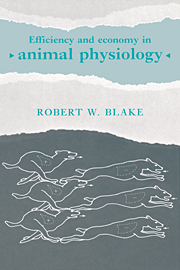Book contents
- Frontmatter
- Contents
- List of contributors
- Preface
- 1 Efficiency, effectiveness, perfection, optimization: their use in understanding vertebrate evolution
- 2 On the efficiency of energy transformations in cells and animals
- 3 Adapting skeletal muscle to be efficient
- 4 Efficiency and other criteria for evaluating the quality of structural biomaterials
- 5 Efficiency and optimization in the design of skeletal support systems
- 6 Efficiency in aquatic locomotion: limitations from single cells to animals
- 7 The concepts of efficiency and economy in land locomotion
- 8 Respiration in air breathing vertebrates: optimization and efficiency in design and function
- 9 Cardiac energetics and the design of vertebrate arterial systems
- 10 An evolutionary perspective on the concept of efficiency: how does function evolve?
- Index
2 - On the efficiency of energy transformations in cells and animals
Published online by Cambridge University Press: 03 October 2009
- Frontmatter
- Contents
- List of contributors
- Preface
- 1 Efficiency, effectiveness, perfection, optimization: their use in understanding vertebrate evolution
- 2 On the efficiency of energy transformations in cells and animals
- 3 Adapting skeletal muscle to be efficient
- 4 Efficiency and other criteria for evaluating the quality of structural biomaterials
- 5 Efficiency and optimization in the design of skeletal support systems
- 6 Efficiency in aquatic locomotion: limitations from single cells to animals
- 7 The concepts of efficiency and economy in land locomotion
- 8 Respiration in air breathing vertebrates: optimization and efficiency in design and function
- 9 Cardiac energetics and the design of vertebrate arterial systems
- 10 An evolutionary perspective on the concept of efficiency: how does function evolve?
- Index
Summary
INTRODUCTION
Biologists study energy transformations in cells and organisms at various hierarchical levels, from biochemical pathway processing through to ecological energetics. The approaches employed to understand them are diverse and field dependent. The methods and approaches commonly used to study energy transformations in mitochondria are not those employed in animal locomotion. Assessments of the effectiveness and performance of energy transformations are often based on efficiency criteria. Arguably, many of the issues concerning the formulation, application and interpretation of efficiency values are of a general nature.
This paper explores six arbitrarily defined themes concerning efficiency. These themes (influence of the choice of formalism on numerical values, dangers associated with commonly expected results, interpreting high and low values, reconciling physiological and mechanical findings, the relevance of laboratory results to field situations, and scaling) are discussed with examples. Some remarks regarding evolutionary perspectives are made in a concluding section.
Numerical results may reflect the choice of formalism and its associated assumptions
Medawar and Medawar (1983, pp. 66–67) argue that the importance of definitions in biology is highly exaggerated, and that biology can proceed without the regard for clear definitions that is essential in mathematics. It may be that tight definitions are not required and/or possible in some areas of biology. However, the definitions and contexts of biological efficiency criteria must be clear. Numerical results reflect the nature of underlying theory. Examples from biochemistry and biomechanics illustrate this below. The context of the application is also important. A given efficiency parameter may refer to a stage of a process, an overall process, or a series of processes. An example from muscle physiology is used to illustrate this point.
There are a number of methods for assessing the efficiency of biochemical pathway processing.
- Type
- Chapter
- Information
- Efficiency and Economy in Animal Physiology , pp. 13 - 32Publisher: Cambridge University PressPrint publication year: 1992
- 1
- Cited by



